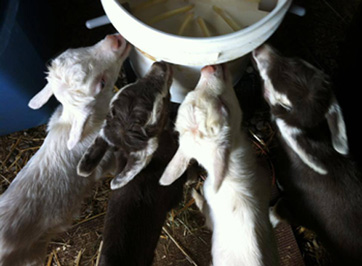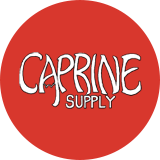Raising Kids

Raising Kids: How We Do It
At Caprine Supply we get lots of phone calls about raising kids. To answer some of these questions, we've written the following guide on how we raise kids. What follows isn't the only way to do it. However, after thirty-five years of experience, this is the system we've found that works the best for us and our goats. 
First Comes Mom: Effective kid raising begins long before the kid ever hits the ground. The dam must be in very good condition. Because any pregnancy is hard on a goat make sure that your does are getting quality hay and grain, that their rations are balanced correctly, and that they have received their immunization shots. 
No Kidding Pens: We keep our pregnant does in their regular pens, even when they give birth. 
People use kidding pens because they're supposed to be cleaner than their regular pens. Our regular pens are cleaned every week and are clean, so we don't see a problem there. Also, if a doe kids in her regular pen, there's usually an older doe around to help clean up kids if the mother gets involved having another kid or just doesn't want to bother with her newborns. 
Watch Those Goats: We check breeding dates and watch our does closely, so we know the "window" when a doe will kid, and we tape her teats with teat tape a few days before. From then on, we keep a very close eye on the doe, and we try to be around at kidding time so we can help if there's a problem. 
Those First Few Hours: When the kid is born, we either let the doe clean it, or we clean it up and dry its coat, using clean old towels and even a hair dryer. We then dip the kid's navel in 7% iodine. We use strong iodine because it cauterizes the navel cord quickly, lessening the chance that bacteria will travel up the cord. 
We Hand-Raise Kids on Pasteurized Milk: We raise all of our kids by hand on pasteurized milk. We do this primarily because we want our kids to be CAE-free and to guard against any other diseases passed through the milk. If you raise kids by hand, there are additional benefits. For example, kids left on their dams drink far more milk than they need, often putting on excess weight and fat. This fat collects on shoulders and in the udder, among other places. And most of this fat never leaves the goat. Like some humans, a fat kid often means a fat adult who rarely milks up to her potential. Also, fat in the udder may mean a less desirable udder. 
In addition, kids raised by hand, bond to you as their mother. This means that they are extremely friendly, they are easy to work with, and they know their place (we're the boss, they're the kid!). 
Those First Feedings: If our new kids are healthy, alert and active, we use a hand-held caprine feeder immediately. The first few feedings are messy: milk all over both the feeder (us) and the "feedee" (the kid), the floor, etc. However, most kids catch on quickly. We let them nurse until they've had 6-8 oz or their stomachs are tight. 
The Problem Child: That's for "normal" kids. What about the problem ones? First, there are "stupid kids." If they're up, alert, and active, but think the caprine nipple is poison, we try feeding with the Pritchard nipple on a pop bottle. If it works, great. If not, we put them back in their nice warm pen for a few hours. Then we try again. It's a miracle how a once "stupid kid" gets the idea when his stomach's growling! It sometimes takes 3-4 hours before a kid gets smart. That's okay as long as the kid is in a nice warm spot and doesn't get chilled. 
Then there are weak kids. If we see a kid isn't responding - it's weak or lethargic - we first rub it all over to stimulate it and get some more warmth into its body. The real trick here is to get the weak kid to nurse. If it doesn't nurse (and we don't let weak kids wait like healthy ones if they don't nurse), we get out the tube feeder and "tube" them. We save lots of kids this way, and we don't hesitate to tube those that need it. 
Bring 'Em Back Alive: We've had luck with some kids we've found lying in bedding with no sign of life. We take them and immerse them (keep their head out!) in a bucket or sink of warmer-than-body-temperature water. This gets their body temperature up. We then wrap them up like mummies to dry them and tube feed them. In some cases we've used a mixture of 2/3's colostrum and 1/3 black coffee. The caffeine gives them a "jolt." 
Out to the Barn: With our normal kids, once they've had their first drink and are dry, we put them out in the barn in our kid pen. We keep a number of kid pens through kidding season, "graduating" kids from one to another as the pens get crowded or the kids outgrow the younger kids being added to the pen. 
When It's -10 degrees F: If the weather's especially cold, we put a couple of sky kennels in the pen for kids to get into. We take the larger kennels apart and get two houses from each kennel. But a word of warning: Kids can pile in these kennels so tightly that the ones at the back can suffocate. Be sure to give kids enough room, and don't use the kennels if there's a big difference in the size of kids or there are weak kids in with active ones. You can use bales of hay or straw to build windbreaks in your kid pens. What you want is a warm, dry, draft-free environment. 
Graduation Day: We feed our kids on the hand-held feeder for about three days. Then, we put them on the regular Caprine feeder. At first it's a big job making sure that each kid stays on and gets its fill. However, the time you take helping them to master the process will save you incredible time over the spring. Once our kids get good at it, we can feed 40 kids in 15 minutes, including clean up! 
Out into the World: When kids are about two weeks old, we move them out of the big barn into our outside kid pens. These pens have sheds, approximately 10' long by 6' deep, with a 2' wide door in front. Each shed has a large yard, 30' by 50'. The yards have "toys" including cable spools and teeter-totters. 
We use hog panel to enclose the yards and hang hay feeders on the inside and grain feeders on the outside of the fencing. The kids stick their heads through the panel to eat the grain. 
It's most important that the pens are kept clean. This means changing their bedding every 4-7 days. Kids that drink milk cycle a huge amount of moisture into the bedding, and dirty, wet bedding means sick kids. 
We begin putting out hay and grain almost immediately. We know very young kids don't eat it, but they begin to get serious about week two. We don't feed much grain to our kids mainly because we don't like fat kids. We figure one cup a feeding until their last month of pregnancy is about right. We do feed a lot of good hay. We like to get their rumen functioning quickly. 
Weaning Day: We like to wean our kids at eight weeks of age. Every once in a while we'll have a kid that needs milk a bit longer to encourage growth. However, a kid that is growing well, eating both grain and hay should be able to move on to a totally "solid food" diet at eight weeks. Other breeders may feed kids longer (up to four or even six months), but for the breeds we've raised, we find that kids fed lots of milk tend to be "fatties," and we like our kids growthy but trim. The key is to monitor how your goats are growing and make your decisions based on your herd and your individual kids. 
Raising kids takes patience and perseverance. But our favorite part of raising goats is watching our kids grow and thrive, turning into milkers that live long productive lives. 
'For a complete line of kid raising products, click on our kid raising section. For products to use for pasteurizing milk, click on our CAE prevention section.






Log In